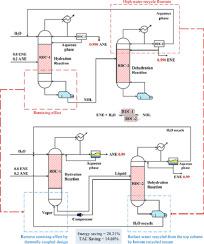Chemical Engineering and Processing: Process Intensification ( IF 4.3 ) Pub Date : 2021-08-15 , DOI: 10.1016/j.cep.2021.108587 Muhammad Ikhsan Taipabu, Felicia Januarlia Novita, Hao-Yeh Lee, Renanto Handogo

|
Separation of close boiling point components such as cyclohexene/cyclohexane is an interesting topic due to the difficulty in its separation process. Recently, the separation of cyclohexene/cyclohexane using two reactive distillation columns has been studied by Yu et al. However, a high energy consumption was presented due to a large amount of water was observed at the bottom of RDC-2 in the conventional RDC (c-RDC). In this work, the chemical-looping technology was applied in which hydration (RDC-1) and dehydration (RDC-2) of cyclohexene was involved. The c-RDC with bottom recycle (br-RDC) was studied. A bottom stream was added to the RDC-2 so that some water could be recycled to the RDC-1. The result showed that the amount of water entered the top decanter could be reduced through the reactive section, thereby the energy consumption of the RDC-2 could be reduced. However, a remixing effect happens in the RDC-1 of both cases. Thus, the thermally coupled configuration based on c-RDC (c-TCRDC) and br-RDC (br-TCRDC) is investigated. The simulation results showed that the br-RDC, c-TCRDC, and br-TCRDC saved 9.87%, 10.64%, and 14.66% in TAC and saved 7.53%, 12.95%, and 28.21% in energy consumption, respectively, compared to the c-RDC.
中文翻译:

通过使用反应蒸馏和热耦合配置的化学循环技术改进环己烯/环己烷分离工艺设计
由于其分离过程的困难,诸如环己烯/环己烷之类的接近沸点组分的分离是一个有趣的话题。最近,Yu 等人研究了使用两个反应蒸馏塔分离环己烯/环己烷。然而,由于在常规 RDC (c-RDC) 中的 RDC-2 底部观察到大量水,因此存在高能耗。在这项工作中,应用了化学循环技术,其中涉及环己烯的水合(RDC-1)和脱水(RDC-2)。研究了底部循环的 c-RDC (br-RDC)。将底部流添加到 RDC-2,以便一些水可以循环到 RDC-1。结果表明,通过反应段可以减少进入顶部滗析器的水量,从而可以降低 RDC-2 的能耗。但是,在两种情况下的 RDC-1 中都会发生重新混合效果。因此,研究了基于 c-RDC (c-TCRDC) 和 br-RDC (br-TCRDC) 的热耦合配置。仿真结果表明,br-RDC、c-TCRDC和br-TCRDC与TAC相比分别节省了9.87%、10.64%和14.66%的能耗,分别节省了7.53%、12.95%和28.21%的能耗。 c-RDC。



























 京公网安备 11010802027423号
京公网安备 11010802027423号